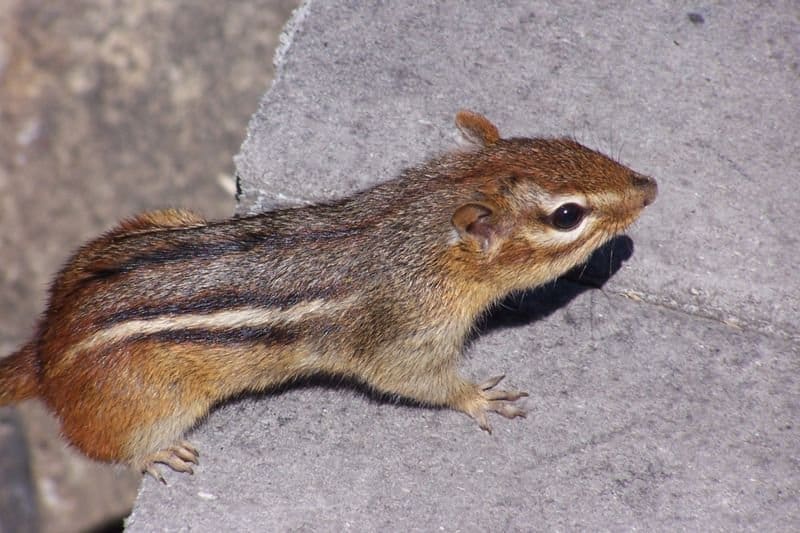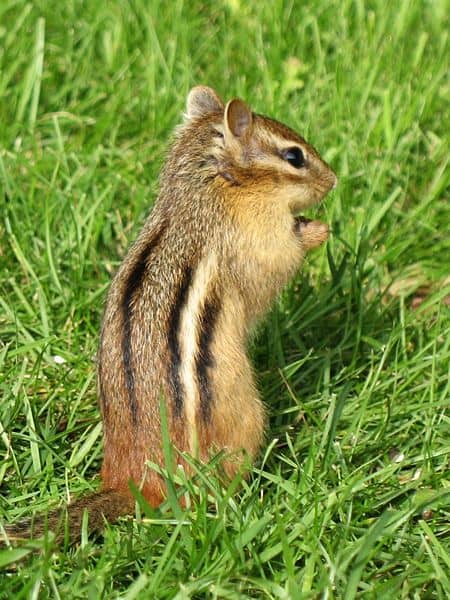Whether there’s a rodent in your home or yard, you may wonder what’s creating all that poop! The good news? It likely isn’t a chipmunk!
Keep reading to learn about chipmunk droppings, how to tell if you’re looking at chipmunk poop, and more!
How do you Identify Chipmunk Poop?

Chipmunk poop is small and oblong.
©Cindy Larson/Shutterstock.com
Chipmunk droppings look similar to rat or mouse droppings. If a chipmunk is nearby, you might see oblong pellets that taper on either end. Chipmunk droppings measure no more than one centimeter and are smaller than rat poop but larger than mice droppings. Chipmunk poop is brown to black, mouse poop is paler, and rat poop looks black.
Less narrow, rice-sized pellets may indicate mice, while even fatter, half-inch-long pellets could mean you have rats in the area.
Finding chipmunk droppings is much rarer than finding mice or rat droppings, though it’s not impossible!
Do Chipmunks Poop Everywhere?
Chipmunks are a prey species. Their poop can attract predators, so they hide it and its odor the best they can. For the most part, chipmunks only poop in a special section of their burrows.
However, you may find chipmunk poop outside of a burrow if they’ve chosen your basement, for instance, as their toileting site. In this case, you wouldn’t find feces everywhere—it would be in concentrated areas only.

Chipmunk burrows typically have areas for sleeping, giving birth, food storage, and pooping.
©iStock.com/mirceax
How do you Clean Chipmunk Poop?
The CDC recommends waiting one week after you’ve last caught a chipmunk to begin cleaning up their droppings. This gives time for any viruses in the stool to die so that they can no longer infect humans.
Then, ventilate the area for at least 30 minutes before cleaning.
- Mix a solution of one part bleach to ten parts water.
- Spray this solution onto the feces and urine and wait five minutes.
- Wearing gloves, pick up the chipmunk droppings using paper towels and throw them in the trash.
- Disinfect the surrounding area with your bleach and water solution.
- Disinfect the floor by mopping, counters or tabletops by wiping, and any furniture the chipmunks may have climbed on using a steam cleaner.
- Wash any bedding, clothes, or other objects that came into contact with the chipmunk using hot water and regular laundry detergent.
Do Chipmunks Dig Holes in Your Yard?

Chipmunk holes lay flat compared to the mounded holes of ants and gophers.
©AndiW, Public domain, via Wikimedia Commons – License
Yes. Chipmunks live in burrows, but they can be challenging to detect. The openings aren’t mounded like ant or gopher holes but instead lay flat and measure just 2-3 inches across.
How do I Know if I Have a Chipmunk in my House?
You might notice a chipmunk by its droppings, as described above, through its sounds, or if you see them. It’s more common to have mice or rats in your home than chipmunks, but sometimes they do get lost!
If this happens, they might spend most of their time hiding in the crevices of your home, attempting to go unnoticed. These prey animals don’t want to interact with humans and rarely present any danger to us—they typically bite only when provoked.
To remove a chipmunk from your home humanely, the Humane Society suggests first trying to let it wander out on its own.
- Lock away any household pets so they cannot hurt the chipmunk or get out of the house themselves
- Shut the chipmunk into a single room.
- Open any doors or windows in the room and leave the chipmunk alone.
Alternatively, try a humane live trap using peanut butter as bait or catch the chipmunk in a towel. If trying the latter method, be sure to wear thick gloves.
Walk slowly to the chipmunk, using the towel to hide, and drop the towel onto the chipmunk. Quickly ball it up around the animal while keeping in mind their size—you don’t want to be rough and hurt them, but you also don’t want them to escape the towel.
Take the chipmunk outside and release it. Chipmunks don’t cause great havoc in the yard—they’ll simply dig some tiny holes, look cute, and potentially chew your garden.
What Times of Day are Chipmunks Most Active?

Chipmunks are diurnal animals.
©Gilles Gonthier, CC BY 2.0, via Wikimedia Commons – License
Chipmunks are diurnal, so they’re most active during the day—kind of like the squirrels in your yard.
Mice and rats, on the other hand, are nocturnal, so you’re less likely to hear or see them during the day.
How Do You Identify Chipmunk Droppings?
Chipmunk poop has a resemblance to those of rats or mice. When a chipmunk is in close proximity, you may observe elongated pellets that narrow at both ends. Chipmunk excrement typically measures no more than one centimeter in length, making them larger than mouse droppings but smaller than rat droppings.
Chipmunk droppings tend to maintain their soft consistency even after several hours, whereas mouse droppings can harden over time.
Furthermore, mouse droppings emit a noticeable odor, unlike chipmunk droppings, which may be odorless. These distinctions make it simpler to detect the presence of mice in your home compared to chipmunks.
How Small of a Space Can a Chipmunk Fit Through?
Chipmunks can fit through an open space about two inches wide. If chipmunks are getting into your home, garage, or other buildings, check the entire exterior for tiny areas like this. You can also check the interior walls for damage, as sometimes it’s easier to see from the other side.
If a chipmunk is getting in, you know there’s a hole somewhere—the struggle will be to find it. After that, keeping them out is as easy as sealing the crevice.
Can a Chipmunk Find its Way Back Home?
A chipmunk can find its way back home from miles away. If releasing a chipmunk you’ve caught in your yard, it’s recommended to take them at least ten miles away to prevent them from returning. However, it’s important to note that chipmunks don’t do tons of damage to structures and rarely find their way inside human homes. It’s more humane to allow them to live out their lives in your yard.
Here are some ways to protect your garden should you choose to do so:
- Plant chipmunk-repellent plants such as daffodils and allium
- Use a humane squirrel repellent
- Block off foundations, sidewalks, porches, and other structures using an L-shaped footer
- Create a gravel border free of plants
- Reduce hiding places for chipmunks like wood or rock piles
- Use bulb cages to prevent chipmunks from damaging bulb plants
The photo featured at the top of this post is © iStock.com/rodmacpherson
Thank you for reading! Have some feedback for us? Contact the AZ Animals editorial team.





